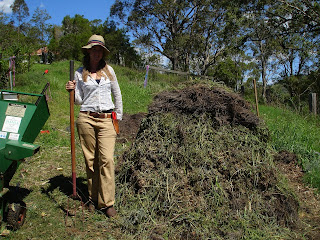I confess; I’ve displayed the symptoms of a typical blogger.
For the first few weeks I eagerly and energetically documented and shared my observations. I marveled at the ordinary, and shared the minutia of my journey. Slowly the day between posts turned into days, then weeks, and obviously my dedication has begun to wane...
Though not for lack of interest! The last several weeks have been so rich and full I’ve scarcely been able to process my own thoughts, let alone translate them in to a legible form.
Since I last posted 20 days ago I have visited six projects in three different states, and traveled approximately 2,556 kilometers. On a whim I temporarily postponed my trip to Tasmania and took a not-so-brief detour…
Here is a very brief summary.
The adventure began with visiting a few farms outside of Melbourne with friends Matty of Dalpura Farm, and Canadian permaculturists Michelle and Rob Avis.
The first stop was a visit to keyline-designed Taranaki Farm, an inspiring 400-acre cattle ranch that is slowly being transitioned from a conventional cattle ranch to a cell grazed, keyline designed example of regenerative agriculture. (Taranaki is one of the hosts of the Regenerative Agriculture workshop series coming up this year, again sponsored by the Australian government's Farm Ready program).
Owner Ben Falloon took us around and showed us the farm.
The brilliant design includes a dam that uses the “road as a roof,” catching water off cleverly placed and graded roads; forest strips that provide wildlife habitat, windbreaks, and perennial cattle forage for the dry season; and a rotating pasture layout that will surely bring regeneration to this brittle piece of land in dry Victoria.
We also got to see the world-renowned compost tea injecting keyline plow that Ben designed and built; you can read about it on Ben's great blog.

Nice work, Ben Falloon and Darren Doherty! I look forward to seeing how this place evolves.
Then came a trip to nearby Daylesford Organics, a family run organic farm with the best looking farmer I’ve ever seen…

Meet Bingo, the canine chicken protector who lovingly protects his flock from predators like foxes. Farmers Brendan and Kate utilizes the chickens as portable tillers and fertilizers, a la Joel Salatin (my new American farm hero). Three flocks of chooks are rotated around the farm in chicken tractors, scratching up finished garden beds and leaving behind their homemade fertilizer. In the meantime these little tillers and fertilizers generate over $20,000 year for the farm by laying around 12 dozen eggs a day. Not bad.
From Daylesford we packed up again. On the way out we hit a cafe and market to grab a cappuccino for the road, and were tickled to see Brendan and Kate's "local low mileage organic beans" lovingly displayed at the counter.

Happily fueled with caffeine, we began the journey across the dry dusty badlands of Southern Australia, a severely degraded, salinated, overgrazed, hot, dry landscape…
….only to arrive at an oasis amidst the desolation.

Welcome to the Food Forest, a family run permaculture farm that doesn’t just survive but actually thrives on 10-12” of rainfall a year.
What an inspiring place!
The Food Forest is by far the most grounded, balanced, abundant demonstration farm I’ve ever been, and they do it in the most harsh environment imaginable. A few days of “work” included winemaking, ciderpressing, fig preserving, apple harvesting – in short, the harvesting, processing, and consumption of delicious food.
I will definitely be writing more about this incredible place soon. In the meantime, check out their educational YouTube channel.
From South Australia it was a few days back on the road, happily processing every detail of the journey with Rob and Michelle, and pondering geeky permaculture topics like the question of appropriate scale, and debating various ways to build soil in drylands.
After dropping off several enormous boxes of Food Forest pistachio and carob at David Holmgren’s 5-acre homestead, Melliodora, we pressed on to Melbourne to visit CERES, an urban environmental education and community center.

While this map doesn't begin to do justice to the vibrancy of the place, it gives you a sense of just how much is going on there smack in the middle of they city. Amazing.
Then it was off to Tasmania, which brings us to the present! I’ve been surveying and keyline plowing and researching and designing a temperate food forest…
And I did all of that traveling with no internet (hence the lack of blogging) – oh yeah, and no tent. I realized at the first campground that while packing my travel bag I threw in the rainfly and not my tent (oops). So I slept in some interesting places, including the top of a picnic table where I got surrounded by fierce Australian possums in the middle of the night.
Anyhow…more on all of the above in the very near future.
I swear.




























